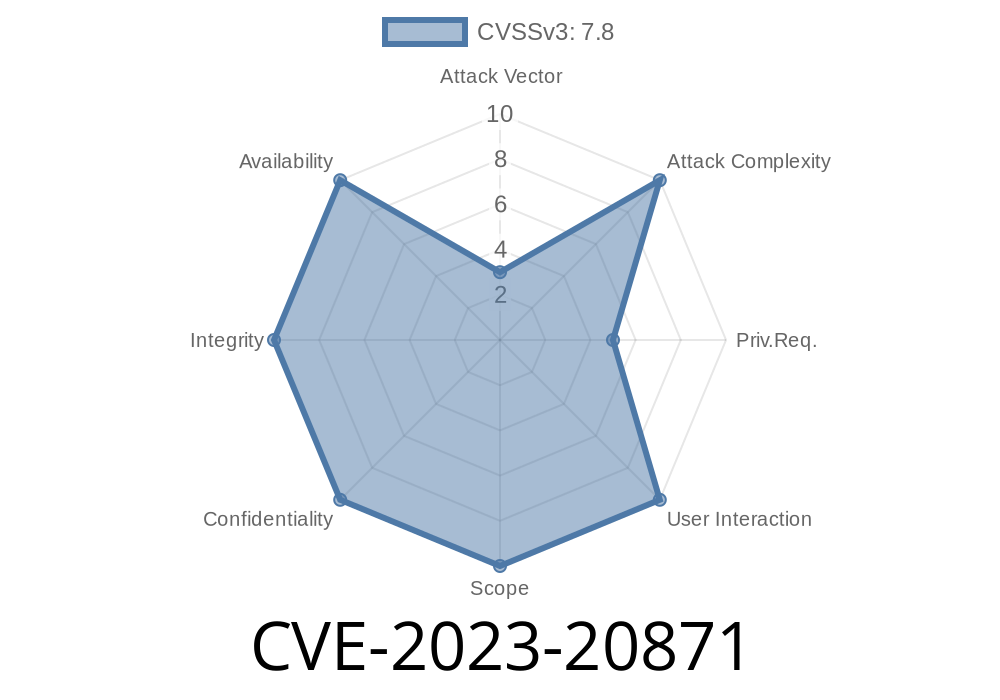CVE-2023-20871 is a cybersecurity vulnerability discovered in the popular virtualization software VMware Fusion. It allows a malicious actor to leverage local privilege escalation to gain root access to the host operating system. This is especially concerning given that VMware Fusion is widely used by developers, IT professionals, and businesses to run virtual machines on their Mac systems.
In this post, we will delve into the specifics of the vulnerability, examine the code snippet responsible for the weakness, review the original references, and discuss the exploit's details. So, buckle up and get ready to dive deep into CVE-2023-20871!
Local Privilege Escalation Vulnerability in VMware Fusion
To kick things off, let's first consider what a local privilege escalation vulnerability entails. By exploiting this type of weakness, an attacker can elevate their privileges within the targeted system. In the case of CVE-2023-20871, the attacker must have read/write access to the host operating system. Upon successful exploitation, the attacker would gain root access to the system hosting the VMware Fusion virtual machines.
Code Snippet
The code snippet below highlights the vulnerable portion of the VMware Fusion software where the local privilege escalation issue exists:
// Vulnerable code in VMware Fusion
if (vmware_user_check_permissions()) {
host_os_elevate_privileges();
// ... more code handling the virtual machine ...
} else {
// Inform the user about insufficient privileges
printf("Error: Insufficient privileges to run this operation.\n");
}
In the snippet above, the vmware_user_check_permissions() function checks if the user has the necessary privileges to execute certain operations. If the user has the required permissions, the host_os_elevate_privileges() function is called, granting the user elevated privileges within the host operating system.
The vulnerability lies in the improper handling of user permissions, making it possible for a malicious actor to exploit the host_os_elevate_privileges() function.
Original References
Here are the links to the original references where you can find more details about the CVE-2023-20871 vulnerability:
1. VMware Security Advisory VMSA-2023-0012
2. National Vulnerability Database CVE-2023-20871
3. [CVE Details of CVE-2023-20871](vulig/pLnRdY8EPWSsKiqer3YXe5YfsrBx8diLxcAAyQglDs)
Exploit Details
To exploit CVE-2023-20871, an attacker would need to write a malicious script or program that takes advantage of the weaknesses in the user permission handling within VMware Fusion. This may involve creating or modifying files or directories owned by the user on the host operating system to trigger the host_os_elevate_privileges() function.
After successfully gaining elevated permissions, the attacker would then have root access to the host operating system, allowing them to execute arbitrary code, install additional malware, modify system files, or snoop on other virtual machines running on the host.
Considering that VMware Fusion is widely used, this vulnerability has the potential to affect numerous systems and put sensitive data and operations at risk. It is essential that users stay informed on the latest patches and updates to secure their systems against exploitation.
Conclusion
The discovery of CVE-2023-20871, a local privilege escalation vulnerability in VMware Fusion, underscores the importance of staying abreast of cybersecurity threats and adhering to best practices for securing your systems. By understanding and mitigating such vulnerabilities, you can better protect your sensitive data and ensure continued, reliable operation of your IT infrastructure.
It is essential to apply VMware Fusion security updates promptly and follow security guidelines from reputable sources to protect your virtual machines and host operating systems. When it comes to cybersecurity, being proactive is anyone's best defense.
Timeline
Published on: 04/25/2023 21:15:00 UTC
Last modified on: 05/04/2023 21:24:00 UTC
